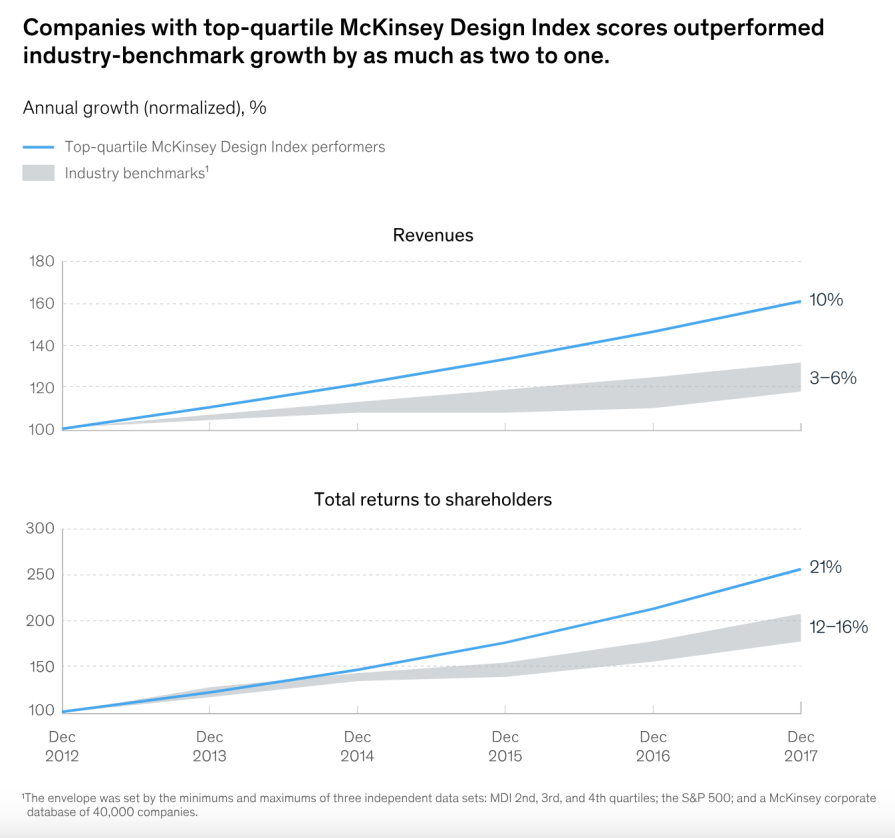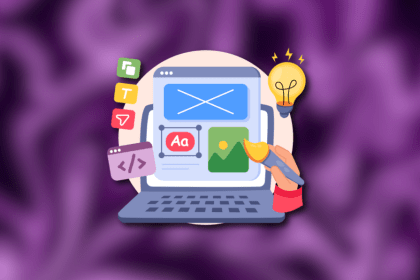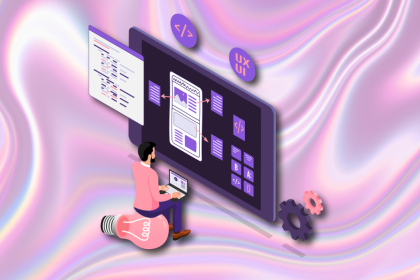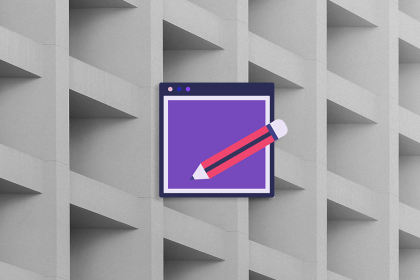If you look at some of the top companies in the world — Apple, Airbnb, IBM, Netflix — what do they all have in common? They are prime examples of design-led companies. Being design-led means more than creating visually aesthetic UIs or hiring design leadership. It means weaving design and user experience into every department, so that experience drives decision-making. Yes, it starts at the top, but it must trickle down. Values like empathy, inclusion, collaboration, and continuous feedback need to be embedded across teams.

Today, nearly every organization wants to be design-led. In a report by McKinsey, strong design-led companies outperformed in revenue growth and shareholder return:

So, it sounds like a no-brainer to train your staff in design principles, right?
The problem is that in reality, business decisions are still mostly driven by product or engineering teams, even if they claim to be design-driven. You might see a research team — but only used when it’s convenient. Or a design leader who isn’t treated as a strategic partner. Design becomes a surface layer used to maintain appearances, while internally, the team struggles for a seat at the table.
In many organizations, designers are seen as service providers, not strategic partners. We’re often asked to “make it look pretty” or quickly mock something up, rather than being invited to meaningful discussions around product direction. When we advocate for research or UX best practices, we’re met with the usual objections — limited time, tight budgets, or “it’s just not worth it.”
This mindset stifles impact. Good UX designers aren’t just Figma monkeys — we bring deep expertise in user research, usability, and product thinking. We help teams validate assumptions, make smarter decisions, and build better experiences from the start. But when our input is consistently dismissed, it can take an emotional toll. We begin to question our value. Burnout creeps in. The passion that once drove us turns into frustration from always having to justify our work.
At this point, designers face a dilemma — quietly comply and do what’s asked, or learn to choose battles strategically. The latter is how we stay resilient and continue to influence the process.
Early in my career, I learned just how emotionally draining it is to constantly advocate for good design. I tried to prove my value by pushing for best practices — always conducting research, delivering accessible designs, and following the ideal design process from end to end. But I was met with resistance. The team had no time for usability testing. Accessibility wasn’t a priority. No matter how much I tried to advocate for a better user experience, I wasn’t being heard. And it took a hit to my confidence. Not only that, but I was starting to seriously burn out.
Eventually, I realized that being a great designer also means reading the room. Not every battle is worth fighting. Sometimes, protecting your energy and showing up sustainably is the smarter play.
It didn’t mean giving up. It meant being more strategic. Fighting every battle burns you out. Fighting smart makes you last.
Culture change is a long game. It won’t happen overnight. But small moments of curiosity can open doors. If leadership asks about your rationale behind a design, or what users think about a feature — that’s your chance to lean in. These are opportunities to educate, plant seeds, and start building trust.
Once, an engineering director I worked with started asking why our releases lacked success metrics. It was the perfect moment to introduce usability tracking and testing. These methods had once been dismissed as “nice to have.” But with support from leadership, we shifted our process. It was a small but meaningful win.
Another long-standing battle I’ve faced is design debt. After repeatedly flagging issues from system upgrades and incorrect implementation, I partnered with my PM and dev team to kick off a formal design debt initiative. While it’s still a struggle to prioritize it against backlog items with clearer business value, we’ve made progress. I still face pushback from developers about the limited amount of resources they have left to tackle design debt after accounting for their current quarter’s priorities.
However, they have accepted design debt just as seriously as technical debt into their work. Updating a component here, cleaning up spacing there — those small improvements start to add up. Not every change has to be big to be worth it. Sometimes, small wins compound, and that’s where real culture change begins.
In parallel, we’ve been working with the design team to improve our design documentation and QA process to prevent new debt from piling up post-release. By tightening up our side of things, we’ve shown the rest of the org that design isn’t just about aesthetics. We care about quality, scalability, and long-term efficiency. That shift in perception helps build trust with stakeholders and opens the door for future collaboration.
Some organizations just aren’t ready to change.
If no one on the leadership team values design, if you have no allies, and if you’re constantly advocating alone — it might be time to move on.
There’s only so much rejection one person can take. Continually having to justify your existence, your process, and your expertise wears you down.
Culture change requires more than one designer.
When design is seen as overhead instead of an investment, you’re judged only on short-term efficiency. If your work doesn’t result in immediate revenue or quantifiable metrics, it’s seen as unnecessary. But UX doesn’t always show impact instantly. Many of the outcomes from UX work are about long-term value, like user retention, satisfaction, and trust. And if an organization doesn’t understand that, you’ll constantly be fighting for air.
Walking away from an organization with low design maturity isn’t accepting defeat. It’s about self-respect and acknowledging that you did the most that one designer can do to try to introduce change. Sometimes the best thing you can do for your career, your confidence, and your craft is to find a place where design is seen not as decoration, but as a driver of real value.
If you’re feeling stuck in a place where you’re facing repeated resistance to investing in usability, then perhaps it’s time to start looking for an environment that values the craft of design. When interviewing for new roles, assess the culture at each company to get a sense of how design is treated within the organization. Here are some questions that you can ask to give you a good sense of the design culture.
“Can you walk me through a recent product decision and how design was involved?”
Asking about design’s involvement during the problem framing stage can tell you if they are valued within the organization. Being involved early on means that design is seen as a partner to product management, and they value conducting user research and discovery alongside each other.
“How does leadership view the role of design in the company’s strategy?”
You can tell a lot by who designers report to. If the company has a Chief Design Officer or VP of Design, then designers are most likely seen as strategic partners, since there is representation at the top of the food chain. Their opinion matters at the executive level and has earned a seat at the decision-making table.
“How do you measure the impact of design?”
An organization that values outcomes over output will gather qualitative and quantitative data in order to measure success. This includes things like usability metrics, net promoter score, and user feedback from testing sessions. If they seem to be focused solely on operational metrics like the number of tickets closed or feature velocity, that may be a red flag.
“Have there been any challenges with design in the past, and how were they addressed?”
With this question, look out for complaints of designers not moving fast enough or being too idealistic. This can signal that the design isn’t truly understood or respected, and is valued only for its ability to produce mockups. A truly design-led company would encourage designers to innovate and take the appropriate steps before delivering designs, including conducting thorough user research.
A designer’s role is often misunderstood. Are we pixel-pushers? Researchers? Facilitators? Strategists? The truth is, we wear many hats. We’re expected not only to design beautiful interfaces but also to advocate for users, lead discovery, and collaborate strategically with cross-functional teams.
Yet, the full scope of our work is rarely seen or appreciated. Unlike our engineering counterparts, whose contributions are measured by what ships, designers are often evaluated solely on what’s visible — the final screens. What gets overlooked is the thinking that happens behind the scenes, like research plans, user interviews, discovery workshops, and all the ideas that never made it to production.
The real challenge isn’t just in what we do, but in helping others understand why it matters. For the designers who have been fighting every day, remember that not every hill is worth dying on. As designers, we can only advocate so much for our users and ourselves. Within a company, you’re only one person. You can keep chipping away, planting seeds, and hoping that, eventually, the team will start to see the value of design.
But sometimes, the organization simply isn’t ready. Some teams aren’t mature enough to leverage design in the way it deserves. And when that’s the case, it’s okay to move on and find a place where your work is respected, your voice is heard, and your impact is felt. Or to start again, hoping this next team will be different.
LogRocket's Galileo AI watches sessions and understands user feedback for you, automating the most time-intensive parts of your job and giving you more time to focus on great design.
See how design choices, interactions, and issues affect your users — get a demo of LogRocket today.

Small actions can have large consequences in complex systems. Here’s how UX designers can manage dependencies so users feel informed and in control rather than blocked or blindsided.

This article examines when hero sections are necessary in digital products, when they create friction, and how to evaluate them using UX goals, primary actions, user flow impact, and real-world alternatives.

AI speeds up tasks like research synthesis, ideation, and first-draft wireframes, but it can’t replace clarity, taste, or decision-making. Here’s a grounded look at what AI actually does well in UX right now.

Discover how to craft UX-friendly hero sections with examples, design tips, and strategies that drive engagement and conversion.